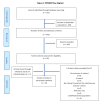Community health worker-based mobile health (mHealth) approaches for improving management and caregiver knowledge of common childhood infections: A systematic review
- PMID: 33437462
- PMCID: PMC7774026
- DOI: 10.7189/jogh.10.020438
Community health worker-based mobile health (mHealth) approaches for improving management and caregiver knowledge of common childhood infections: A systematic review
Abstract
Background: Children in lower middle-income countries (LMICs) are more at risk of dying, than those in High Income Countries (HICs), due to highly prevalent deadly yet preventable childhood infections. Alongside concerns about the incidence of these infections, there has been a renewed interest in involving community health workers (CHWs) in various public health programs. However, as CHWs are increasingly asked to take on different tasks there is a risk that their workload may become unmanageable. One solution to help reduce this burden is the use of mobile health (mHealth) technology in the community through behaviour change. Considering there are various CHWs based mHealth approaches on illness management and education, therefore, we aimed to appraise the available literature on effectiveness of these mHealth approaches for caregivers to improve knowledge and management about common under-five childhood infections with respect to behaviour change.
Methods: We searched six databases between October to December 2019 using subject heading (Mesh) and free text terms in title or abstract in US English. We included multiple study types of children under-five or their caregivers who have been counselled, educated, or provided any health care service by CHWs for any common paediatric infectious diseases using mHealth. We excluded articles published prior to 1990 and those including mHealth technology not coming under the WHO definition. A data extraction sheet was developed and titles, abstracts, and selected full text were reviewed by two reviewers. Quality assessment was done using JBI tools.
Results: We included 23 articles involving around 300 000 individuals with eight types of study designs. 20 studies were conducted in Africa, two in Asia, and one in Latin America mainly on pneumonia or respiratory tract infections followed by malaria and diarrhoea in children. The most common types of Health approaches were mobile applications for decision support, text message reminders and use of electronic health record systems. None of the studies employed the use of any behaviour change model or any theoretical framework for selection of models in their studies.
Conclusions: Coupling mhealth with CHWs has the potential to benefit communities in improving management of illnesses in children under-five. High quality evidence on impact of such interventions on behaviour is relatively sparse and further studies should be conducted using theoretically informed behaviour change frameworks/models.
Registration: PROPSERO Registration number: CRD42018117679.
Copyright © 2020 by the Journal of Global Health. All rights reserved.
Conflict of interest statement
Competing interests: The authors completed the ICMJE Unified Competing Interest form (available upon request from the corresponding author) and declare no conflicts of interest.
Figures
References
-
- Pakistan Bureau of Statistics. List of Diseases 2019 [updated 2019]. Available: http://www.pbs.gov.pk/content/list-diseases. Accessed: 13 December 2019.
-
- Kyu HH, Pinho C, Wagner JA, Brown JC, Bertozzi-Villa A, Charlson FJ, et al. Global and national burden of diseases and injuries among children and adolescents between 1990 and 2013: findings from the global burden of disease 2013 study. JAMA Pediatr. 2016;170:267-87. 10.1001/jamapediatrics.2015.4276 - DOI - PMC - PubMed
-
- National Institute of Population Studies. Pakistan Demographic Health Survey 2017-18: Maryland: The DHS Program; 2019. Available: https://dhsprogram.com/pubs/pdf/FR354/FR354.pdf. Accessed: 16 December 2019.



